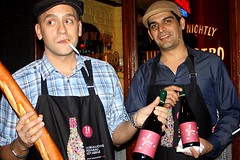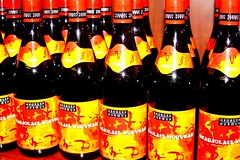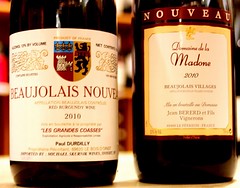Wielding an 18-inch baguette in one hand and a bottle of Beaujolais Nouveau in the other, Luis da Silva marched around Jules Bistro on St. Marks Place Thursday night wearing a kitschy black apron.
Le Beaujolais est arrive! the manager’s apron declared, the universal cry that the young, fruity, barely fermented (and to some, barely drinkable) wine has hit the shelves and bars.
Around the world, the third Thursday of November marks the official release of Beaujolais Nouveau, the wine crushed from 100 percent Gamay grapes from the Beaujolais region of France, in the southernmost part of Burgundy.
Most wine connoisseurs, vendors and drinkers agree that Beaujolais Nouveau isn’t actually that tasty. A marketing ploy, an advertising maneuver – call it what you will – it’s no secret that the Beaujolais Nouveau is marketed to be a grandiose event, albeit misguided.
French native Geoffroy de Guibert, who met a handful of other French friends for the celebration at Jules Bistro, says, “No, it’s not good. You know it’s not a good wine. You know it’s kind of a disgusting wine, but it happens once a year. It’s just for the event.
Because the wine is not aged, it is best served chilled (and is likely to taste worse as it warms to room-temperature). And while it may not stimulate your palate, the young wine can serve as an indicator of the vintage’s success. Each year the nouveau tastes different: last year it hinted at banana, this year the jury’s still out. “It’s about the weather, it’s about rain, it’s about sun,” says Chloé Descombes, another French native celebrating the event at Jules Bistro, agrees. This year? “I’d say it’s a good wine,” says Ms. Descombes.
For some East Village wine shops, the release of the wine is a cause for a fete but for others absolument pas!
At Astor Wines & Spirits on Lafayette, five brands of Beaujolais Nouveau stand prominently on display next to “Thanksgiving Wines.” The wine store bought almost 1,500 bottles of the wine this year, offering a range of houses from goliath Georges Duboeuf to the small, organic Pacalet. Parallel to Discovery Wines, the Beaujolais Nouveau’s at Astor Wines & Spirits sell for between $9.99 and $11.99, and should preferably be drunk within the first three months of arrival.
Tim Mortimer, general manager of Discovery Wines on Avenue A says Beaujolais Nouveau “doesn’t have to be insipid.” The wines from the two brands the store carries are “light, simple, fruit-forward and refreshing,” he says.
As diners sipped on Beaujolais Nouveau and savored regional Beaujolais dishes such as duck sausage with lentils and bacon, the earthy, jazzy chords of Jessy Carolina & The Hot Mess seeped out of Jules Bistro. A few blocks away on Avenue B, Guillaume Blestel, the owner of Casimir, decided not to offer Beaujolais Nouveau, but says he understands those who do. “If you do it, you have to do it all the way.” Mr. Blestel doesn’t find the product particularly alluring, but says it is beneficial for determining how the 2010 vintage will taste.
 C.C. Glenn Workers at Jules Bistro, 65 St. Marks Place, show off their selection of Beaujolais Nouveau 2010.
C.C. Glenn Workers at Jules Bistro, 65 St. Marks Place, show off their selection of Beaujolais Nouveau 2010.Harveen Bonnet, the manager at Flea Market Café, also decided not to carry the wine this year. In 2002, Bonnet says the French bistro bought 25 cases of Beaujolais Nouveau that were drunk within three days. But in 2007, the cafe bought one case that still wasn’t completely sold by Christmastime.
In France, says Mr. Bonnet, the wine is still cheap. “It’s one more reason to get wasted with cold cuts and cheese,” he says. But here in America, “People are more educated and the wine is getting more expensive,” says Mr. Bonnet.






